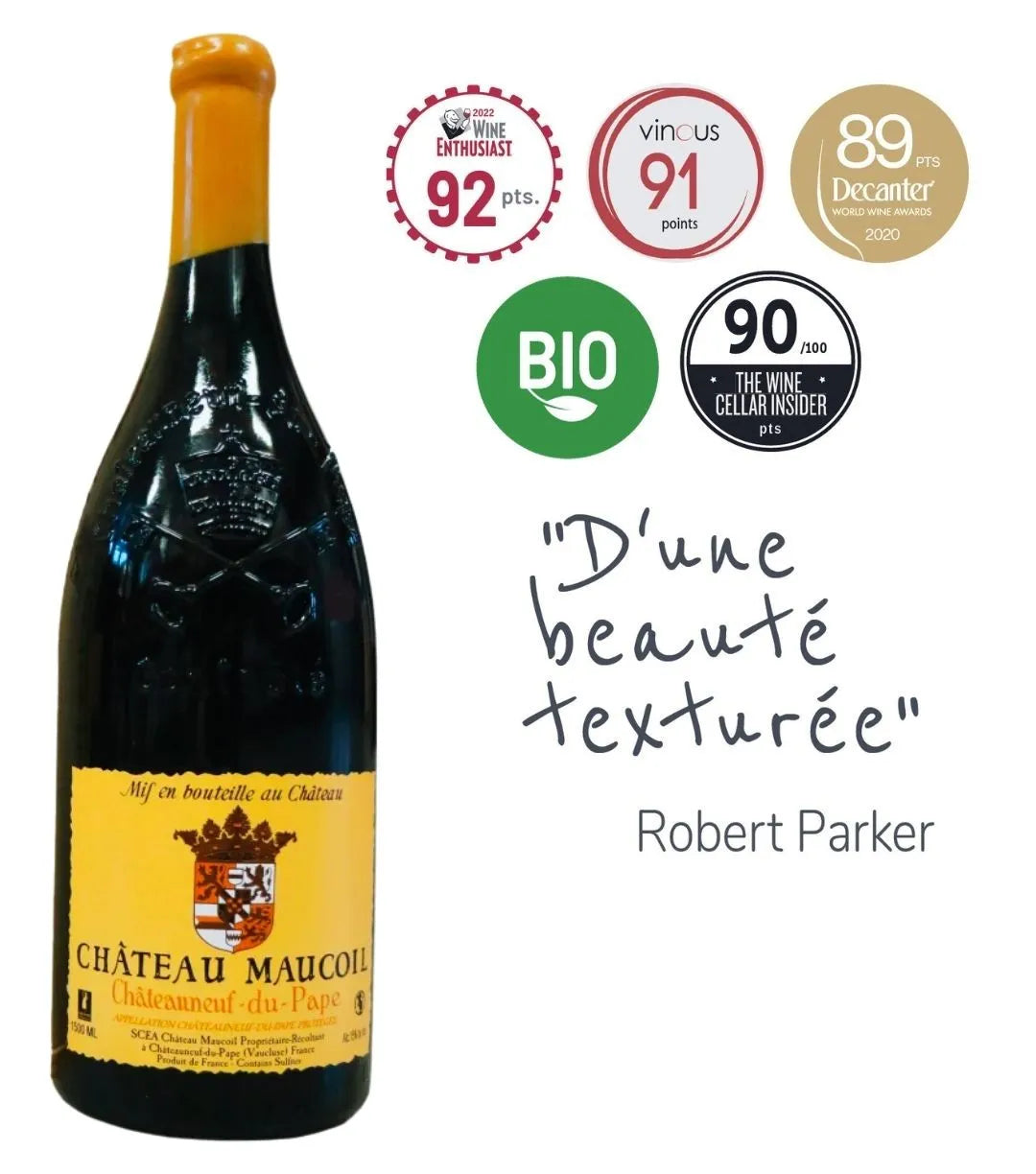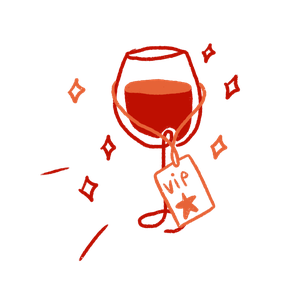
Our Red and White Wines from Châteauneuf-du-Pape
Our Red and White Wines from Châteauneuf-du-Pape
If you love wines rich in history and flavors, then Châteauneuf-du-Pape should be at the top of your list. These exceptional wines, from the sunny terroir of the southern Rhône Valley, are adored by wine enthusiasts worldwide. Discover our selection of white and red Châteauneuf-du-Pape!

Châteauneuf-du-Pape AOC Rhône, France

Châteauneuf-du-Pape AOC Rhône, France

Châteauneuf-du-Pape AOC Rhône, France

Châteauneuf-du-Pape AOC Rhône, France

Châteauneuf-du-Pape AOC Rhône, France

Côtes du Rhône Villages AOC Rhône, France

Châteauneuf-du-Pape AOC Rhône, France
Our Red and White Wines from Châteauneuf-du-Pape
Under the Papal Seal: The Bottle and History of Châteauneuf-du-Pape
One of the most recognizable symbols of Châteauneuf-du-Pape is undoubtedly its engraved bottle. This bottle adorned with papal arms, representing the crossed keys of Saint Peter under a papal tiara, was introduced to guarantee the wine's authenticity and perpetuate its prestigious heritage. This distinctive seal has become a mark of quality and an emblem of the appellation.
This iconic bottle reminds us that the history of Châteauneuf-du-Pape is deeply linked to that of the Avignon popes. Established in the 14th century, they greatly favored the vineyard's development by encouraging vine cultivation and imposing strict production rules. This commitment to ensuring wine excellence led, much later, to the establishment of the Appellation d'Origine Contrôlée (AOC), of which Châteauneuf-du-Pape was one of the precursors.
A Unique Terroir Shaped by Nature
The terroir of Châteauneuf-du-Pape is one of the most characteristic in the Rhône Valley. Its soil is mainly composed of rolled pebbles, sand, clay, and limestone, bringing diversity conducive to wine complexity. The rolled pebbles, transported by the ancient Rhône riverbed, accumulate the sun's heat during the day and release it at night, thus promoting optimal grape ripeness. The Mediterranean climate, marked by strong sunshine and the mistral wind that keeps the vines healthy, also contributes to the exceptional quality of Châteauneuf-du-Pape wines.
Châteauneuf-du-Pape Red: Power and Complexity
Châteauneuf-du-Pape red is a generous, intense wine built for aging. It comes from a blend of several grape varieties, with Grenache, Syrah, and Mourvèdre in the lead. Each sip reveals notes of ripe black fruits, spices, garrigue, and sometimes a slightly smoky touch.
This wine perfectly accompanies grilled meats, sauced dishes, and game. And for those who like wines that age well, know that red Châteauneuf-du-Pape can improve for 10, 15, even 20 years!
Châteauneuf-du-Pape White: Freshness and Finesse
Less known than its red counterpart, white Châteauneuf-du-Pape is nevertheless a rare gem worth lingering over. Only 5% of the appellation's production is dedicated to whites, making it a more exclusive wine. It features grape varieties such as Roussanne, Grenache Blanc, and Clairette, which bring freshness, roundness, and complexity.
White Châteauneuf-du-Pape stands out for its floral aromas, white-fleshed fruits, and sometimes notes of honey and almond. It pairs wonderfully with sauced fish, seafood, and even certain aged cheeses.
Grape Varieties and Field Blending in Châteauneuf-du-Pape
One of Châteauneuf-du-Pape's peculiarities is the diversity of its grape varieties. The appellation allows up to 18 different grape varieties, a unique richness in France. This field blending – that is, the cohabitation of several grape varieties in the same plot – allows for great aromatic complexity and a beautiful expression of the terroir.
For reds, the main grape varieties are:
- Grenache (dominant, it brings fruitiness and roundness)
- Syrah (structure and spices)
- Mourvèdre (tannins and aging potential)
- Cinsault, Counoise, Muscardin, Terret Noir, Vaccarèse (in lesser proportion, for finesse and complexity)
For whites, we find:
- Grenache Blanc (body and structure)
- Roussanne (floral aromas and elegance)
- Clairette (freshness and liveliness)
- Bourboulenc, Picpoul, Picardan (in small quantities, for balance)
Why Choose a Châteauneuf-du-Pape?
- An exceptional terroir: rolled pebbles that store heat and promote grape ripeness.
- A historic appellation: the Avignon popes played a key role in the recognition of this vineyard.
- Wines with character: perfect for special occasions or to treat yourself!
Your Questions, Our Answers on Châteauneuf-du-Pape Wines
Where is Châteauneuf-du-Pape located? Châteauneuf-du-Pape is located in the southern Rhône Valley, between Avignon and Orange, in Provence.
What is the origin of the name Châteauneuf-du-Pape? The name comes from the Avignon popes, who stayed in Châteauneuf in the 14th century and promoted the vineyard's development.
How many grape varieties are allowed in Châteauneuf-du-Pape? We often talk about 13 allowed grape varieties, but this number rises to 18 if we consider color variations for certain varieties. For example, Grenache can come in Grenache Noir, Grenache Blanc, and Grenache Gris.
What is the price of a Châteauneuf-du-Pape? The price varies according to the producer and vintage, but bottles generally range between 30 and 100 euros, or more for exceptional cuvées.
What is the difference between red and white Châteauneuf-du-Pape? Red is powerful and full-bodied with spicy and fruity notes, while white is rarer, offering freshness and finesse.
What is the aging potential? Reds can age 10 to 20 years, while whites are often consumed young but can evolve over time.
What are the best vintages of Châteauneuf-du-Pape? Among recent ones, 2022, 2020, and 2019 are particularly successful, offering power and balance. For fans of old vintages, 1998, 2001, 2005, and 2010 are must-have references that stand out for their aging ability and aromatic complexity.
What to eat with a white Châteauneuf-du-Pape? It pairs perfectly with noble fish in sauce (sea bass, turbot), seafood, as well as uncooked pressed cheeses like Comté.
What dish with a red Châteauneuf-du-Pape? Sauced meats (beef bourguignon, wild boar stew) and game (venison, duck) are classic choices. It also goes well with Mediterranean dishes like a tagine with sweet spices.
Whether you're an amateur or a connoisseur, white and red Châteauneuf-du-Pape wines will seduce you with their richness and authenticity. Enjoy your tasting!
Return to the Rhône Valley wines page.









